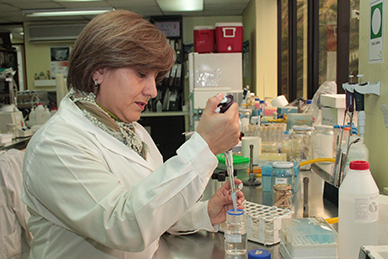- María Angélica Ganga, researcher at the Technological Faculty, leads a project to make technological improvements to the Pajarete wine fermentation in Huasco Valley. The project has been funded through the Innovation for Competitiveness Fund and has allowed improving the quality of this traditional product and recovering its original properties.
It is said that Jesuits brought the Pajarete wine to the north of Chile during the 17th century. This wine is characterized by its sweet flavor and it is produced mainly from black and muscatel grapes of the northern part of the country.
In the last few years, the Pajarete production has had a significant increase due to a development plan that has allowed local producers to commercialize it in better conditions, thanks to a strategy that allowed producing a first-quality product, including appellation of origin (geographical indications).
In this process, the Atacama Regional Government and the Association of Pajarete Producers of Huasco Valley have worked together with Universidad de Santiago in a project to make technological improvements to this wine fermentation process in order to improve its competitiveness.
The project- funded through the Innovation for Competitiveness Fund of the Atacama Region- has been led by María Angélica Ganga, PhD in Biological Sciences and a researcher at the Technological Faculty of Universidad de Santiago.
The researcher says that the project focused in strengthening the Pajarete production through the microbiological control of the vinification process and the selection and identification of native yeasts.
This is how a microbial strain collection was created and yeasts with technological potential for production were obtained. Besides, a standard methodology for their use was developed and handed to wine producers.
The researcher explains that Pajarete producers contacted the University and expressed their concern for having lost part of the properties of their wine in their attempt to industrialize their process and also for using yeasts different from the ones of the Atacama Region, what led to losing part of their “terroir” (the set of characteristics that describe and define a geographic region where grapes are grown).
“So, we worked to return the organoleptic properties to the product by using yeasts from that region. Now, the fact of recovering these properties allows the producers to keep the hallmark of a wine typical of that region; it is something of their own that is not reproducible in other regions,” she explains.
Anberta Debia, a Pajarete producer and member of the Association of Pajarete Producers, considers that the most important achievement of this project is that old people at Huasco Valley identified this new Pajarete with the one that was produced in this area decades ago.
“When we started working with industrial yeasts, people did not identify themselves with the product. Now we know that everybody thinks that the wine is more tasty, more aromatic and with a more fresh-raisin flavor. The grape is reflected in a much better way and that gives us a plus,” she says.
According to the producers, now that the quality production stage has been completed the following stage is to commercialize the product.
Their first objective is to get their product distributed in Santiago and the rest of the country and then, start exporting.
Opportunities for the industry
At present, Universidad de Santiago is implementing a new project with the purpose of developing a sustainable production system to provide Pajarete producers with the amount of yeast required for the their wine making.
At the same time, the University is applying for a third project to help producers to assure the innocuousness of the product, in order to become competitive, not only at a national level, but also at an international one.
Nibaldo Guaita, who is in charge of the Production Development Area of the Atacama Regional Government, describes the work done as very positive. He says that the problem with this wine was related to the fermentation process, which affected its quality. Now he bets that Pajarete will become a premium wine.
“We want to position Huasco Pajarete producers as a national example, with a high-quality wine that can compete with other sweet wines. This product already has the best level possible and this will help to reach a better market,” he says
Nibaldo Guaita said that they have taken the Pajarete wine to different international fairs and that it has awakened interest, but on these occasions, a new big challenge has arisen: to increase the volume of production.
Translated by Marcela Contreras



